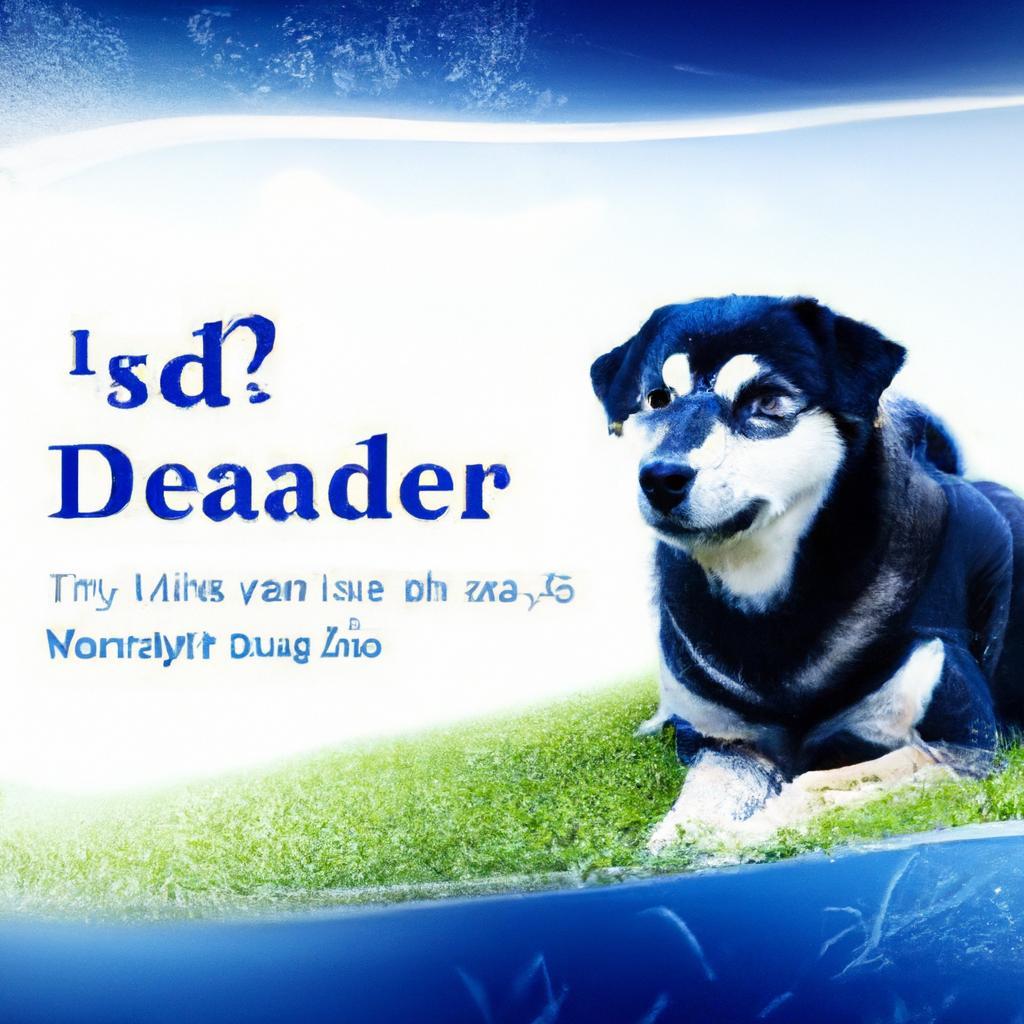When Max, a lovable Labrador, first arrived at the shelter, he was labeled as “XL.” At first, it seemed like just a size designation, but soon it became clear that XL meant so much more. It stood for “eXtra Love.” Max, with his big heart and even bigger paws, brought joy to everyone he met. His XL size meant he could cuddle more, play harder, and protect fiercely. Adopting an XL dog like Max means welcoming a loyal companion who will fill your life with boundless affection and unforgettable adventures. Choose XL; choose love.
Contents
- Understanding the XL Dog Size Classification and Its Implications
- Evaluating the Health and Care Needs of XL Dog Breeds
- Choosing the Right XL Dog for Your Lifestyle and Environment
- Essential Training and Socialization Strategies for XL Dogs
- Q&A
Understanding the XL Dog Size Classification and Its Implications
When it comes to canine companions, size matters significantly, especially for those considering welcoming an XL dog into their home. The classification of XL dogs typically refers to breeds that weigh over 100 pounds and stand at least 24 inches tall at the shoulder. This category encompasses a variety of breeds, including Great Danes, Mastiffs, and St. Bernards, each with unique characteristics and needs. Understanding this classification is crucial for potential dog owners, as it influences not only the dog’s care requirements but also the dynamics of living with a larger pet.
Owning an XL dog comes with specific implications that prospective owners should consider. **Space requirements** are paramount; these dogs need ample room to move around comfortably. A spacious home with a secure yard is ideal, as XL breeds thrive in environments where they can stretch their legs and play. Additionally, **exercise needs** are significant; these dogs require regular physical activity to maintain their health and prevent behavioral issues. Daily walks, playtime, and mental stimulation are essential components of their routine.
Moreover, the **financial commitment** associated with XL dogs is often greater than that of smaller breeds. Larger dogs typically consume more food, which can lead to increased grocery bills. Veterinary care, including vaccinations, routine check-ups, and potential emergency treatments, can also be more expensive due to the size of the dog. Prospective owners should be prepared for these costs and ensure they can provide for their pet’s needs throughout its life.
the **social dynamics** of owning an XL dog can differ significantly from smaller breeds. Larger dogs often attract attention, and their size can be intimidating to some people. It’s essential for owners to socialize their XL dogs from a young age to ensure they are well-adjusted and friendly. Training is also crucial; a well-trained XL dog can be a gentle giant, while a lack of training can lead to challenges in behavior and control. Understanding these aspects is vital for anyone considering bringing an XL dog into their family.
Evaluating the Health and Care Needs of XL Dog Breeds
When considering the health and care needs of XL dog breeds, it’s essential to recognize their unique physiological characteristics. These larger-than-life companions often face specific health challenges that require vigilant attention from their owners. **Joint issues**, such as hip and elbow dysplasia, are prevalent in XL breeds due to their size and weight. Regular veterinary check-ups and maintaining a healthy weight can significantly mitigate these risks.
Nutrition plays a pivotal role in the well-being of XL dogs. Their dietary requirements differ from smaller breeds, necessitating a balanced diet rich in essential nutrients to support their growth and overall health. **High-quality protein**, **healthy fats**, and **appropriate calcium levels** are crucial to prevent developmental issues. Owners should consult with veterinarians to tailor a feeding plan that meets the specific needs of their XL breed, ensuring they receive the right amount of food at the right life stage.
Exercise is another critical component of maintaining the health of XL breeds. While they may not require as much exercise as some smaller, more energetic breeds, regular physical activity is vital to keep them fit and mentally stimulated. **Daily walks**, **playtime**, and **interactive games** can help prevent obesity and promote cardiovascular health. Engaging in activities that challenge their minds, such as obedience training or agility courses, can also enhance their overall quality of life.
Lastly, socialization and mental health should not be overlooked. XL breeds can be prone to anxiety and behavioral issues if not properly socialized from a young age. **Exposure to various environments**, **people**, and **other animals** is essential to develop a well-rounded temperament. Owners should prioritize positive experiences and training to foster confidence and reduce stress, ensuring their XL companions thrive both physically and emotionally.
Choosing the Right XL Dog for Your Lifestyle and Environment
When considering an XL dog, it’s essential to evaluate how their size aligns with your lifestyle. Large breeds often require more space, both indoors and outdoors. If you live in a small apartment or a home without a yard, you may find it challenging to provide the necessary room for an XL dog to thrive. **Assess your living situation** to ensure it can accommodate a larger breed comfortably, allowing them to move freely and engage in physical activities.
Another critical factor is your activity level. XL dogs typically need regular exercise to maintain their health and happiness. If you lead an active lifestyle, you might find a large breed to be a perfect companion for outdoor adventures, such as hiking or running. However, if your routine is more sedentary, consider whether you can commit to daily walks and playtime. **Evaluate your daily schedule** and ensure you can dedicate time to meet the exercise needs of a larger dog.
Socialization and training are also paramount when choosing an XL dog. These breeds can be strong-willed and may require consistent training to ensure they are well-behaved. If you have children or other pets, it’s crucial to consider how an XL dog will fit into your family dynamic. **Research specific breeds** to understand their temperament and compatibility with your household. A well-socialized dog can be a loving and gentle giant, while a poorly trained one may pose challenges.
Lastly, consider the financial implications of owning an XL dog. Larger breeds often come with higher costs for food, grooming, and veterinary care. **Budget accordingly** to ensure you can provide for your dog’s needs throughout their life. Investing in quality food and regular check-ups is essential for their health and longevity. By taking these factors into account, you can make an informed decision that aligns with your lifestyle and environment, ensuring a harmonious relationship with your new furry friend.
Essential Training and Socialization Strategies for XL Dogs
Training XL dogs requires a tailored approach that acknowledges their size, strength, and unique temperament. **Positive reinforcement** is one of the most effective methods for training these large breeds. This technique involves rewarding desired behaviors with treats, praise, or playtime, which encourages them to repeat those behaviors. Consistency is key; using the same commands and rewards will help your XL dog understand what is expected of them. Additionally, incorporating **short, engaging training sessions** can keep their attention focused and make learning enjoyable.
Socialization is equally crucial for XL dogs, as it helps them develop into well-rounded companions. Early exposure to various environments, people, and other animals can significantly reduce the likelihood of behavioral issues later in life. Consider enrolling your dog in **puppy classes** or arranging playdates with other dogs to foster positive interactions. Always supervise these encounters to ensure safety and to guide your dog in appropriate social behaviors. Remember, the goal is to create a confident dog that feels comfortable in diverse situations.
Incorporating **mental stimulation** into your XL dog’s routine is essential for their overall well-being. Large breeds often have a lot of energy, and without proper outlets, they may resort to destructive behaviors. Engage their minds with puzzle toys, obedience training, or scent work. These activities not only provide physical exercise but also challenge their intellect, keeping them mentally sharp and satisfied. A tired dog is a happy dog, and mental challenges can be just as exhausting as physical ones.
Lastly, establishing a strong bond with your XL dog through **trust and respect** is vital for effective training and socialization. Spend quality time together, whether through walks, play, or simply relaxing at home. This connection will make your dog more receptive to training and social experiences. Always approach training with patience and understanding, as large breeds can sometimes be sensitive to harsh corrections. By fostering a positive relationship, you’ll create a loyal companion who is eager to learn and engage with the world around them.
Q&A
-
What does XL mean when referring to a dog?
XL stands for “extra large,” indicating a size category for dogs that are significantly larger than standard breeds. This classification helps potential dog owners understand the size and space requirements of the breed.
-
Which breeds are considered XL dogs?
Common XL dog breeds include the Great Dane, Mastiff, Saint Bernard, and Newfoundland. These breeds are known for their impressive size and stature, making them stand out in any setting.
-
What are the care considerations for XL dogs?
XL dogs require special attention in terms of diet, exercise, and health care. Their larger size means they may have unique nutritional needs and are more prone to certain health issues, such as joint problems. Regular veterinary check-ups are essential.
-
Is an XL dog suitable for my lifestyle?
Before adopting an XL dog, consider your living space, activity level, and commitment to training. These dogs thrive in environments where they have ample space to move and play, making them ideal for families with large yards or active individuals.
understanding what “XL” means for a dog is crucial for ensuring your pet’s comfort and well-being. By choosing the right size, you invest in their happiness and health. Make informed decisions for your furry friend today!




